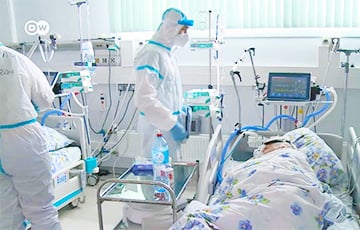COVID-19 Situation in Vitsebsk: There Have Never Been So Many ICU Beds
11- 21.10.2021, 20:07
- 24,494

The regional center has again become a hot spot.
Vitsebsk, which was the epicenter in the first wave, has again become a hot spot. Nasha Niva talked with city doctors about the workload of hospitals, the age of patients in intensive care, and student teams.
“The average age of patients in intensive care is about 40 years. It used to be about 50"
Doctors note that the influx of patients is greater than in the previous wave. So, the Vitsebsk emergency hospital redesigned the first building for covid in early September. And by the end of the month, the entire hospital was given over to patients with coronavirus, although it was planned that this would happen a week and a half later.
“The situation in the city as a whole is more difficult in the sense that now there is not a single hospital left that would not treat coronavirus patients. Previously, we always had a clean cardiological dispensary. And just a week ago, even it was partially re-profiled,” says resuscitator Rostislav Savitsky.
The emergency hospital has about 500 beds. Recently, there have been more of them, as additional ones have been delivered - in some wards, for example, there are four instead of three. The extra beds were deployed on the floor in the maternity hospital, where the chair and classes were supposed to be.
“In the previous waves, we had about 30 intensive care beds. Now - 46. There has never been such a number. This is a lot, and, based on this, one can judge the severity of the disease. Moreover, the beds are almost always full. Every morning we report on them - we have a maximum of one free place. They are usually filled with people who need oxygen support and who have a threatening condition.
There are more young people. Among those who die, 70 percent are people over 70 years old. But there are also 30-year-olds, which is especially difficult for us morally and physically. If you look at intensive care, two-thirds are occupied by people under 65 years of age. The average age of those who lie there is about 40. Previously, this age used to be about 50 years,” the doctor draws attention.
Typically, patients are kept in the hospital for about 10 days (as prescribed by the protocol). If the condition is not threatening, they are discharged. Sometimes these days are not enough for treatment, but given the large influx of patients, people have to be discharged in order to admit new ones.
"Such a large influx is most likely associated with a new strain that came to Belarus or developed in our own country. In principle, it was predicted that the peak of infection would begin in the fall. But nobody could assume that it would be that severe.
Judging by the previous administrative decisions, we were not fully prepared. Nothing radically new was undertaken to protect the population from infection.
And people who have lived for a year and a half in coronavirus conditions are simply tired of all this. It can be seen that the consciousness that was in the first wave has decreased. Then people were afraid to get infected more and became more active in the fight against coronavirus: they wore masks and kept the social distance. Now many people began to hope that they will be lucky. And that, too, has its negative consequences."
"Some of the medical students left to work in their cities"
In the regional hospital, only the main building remains clean.
“Several departments are filled with only covid patients. The intensive care unit is full. We opened another intensive care unit with eight beds, increased the intensive care unit in the urological building to 12 people. The doctors are trying, but there are still few beds,” a doctor who works in this institution says.
Many students are involved to help the doctors - both in the polyclinic and in the regional hospital - and to call people. Some of the young people have left for their towns. Those who help with patients have been transferred to distance learning.
"I started working in the previous wave, but this one is bigger: there are not enough available beds. The course of the disease is monotonous - fever, lack of air, oxygen deprivation. The classic picture of pneumonia," says the interlocutor.
He had been ill with coronavirus in November.
“As a preventive measure, I wash my hands, wear a mask and change it periodically, take vitamins. I don’t use antiseptic outside of work.”
It is official: the number of covid pneumonia is higher than in the previous waves.
In the Vitsebsk region, 4,100 beds were redesigned for patients with covid (this is 35% of all beds available in hospitals in the region), of which 2,178 are in Vitsebsk.
Coronavirus patients in the city are treated at the regional hospital, the regional infectious diseases hospital, the city emergency hospital, the regional skin clinic, the regional maternity hospital, the center for pulmonology and phthisiology, the medical rehabilitation center, the children's clinical center, the clinical oncology clinic, the 1st city hospital, and the regional clinical specialty center.
If in the past waves there were 3.5 thousand patients with covid pneumonia at the peak, now there are 3.8 thousand of them. Such figures were recently announced by the chairman of the regional executive committee Nikolay Sherstnev. Hospitals use 84% of the available oxygen points.
According to statistics, the number of vaccinated among those who are in hospitals is two to three percent.
More than 200 students of Vitsebsk Medical University are employed in polyclinics, ambulance stations, hospitals.









